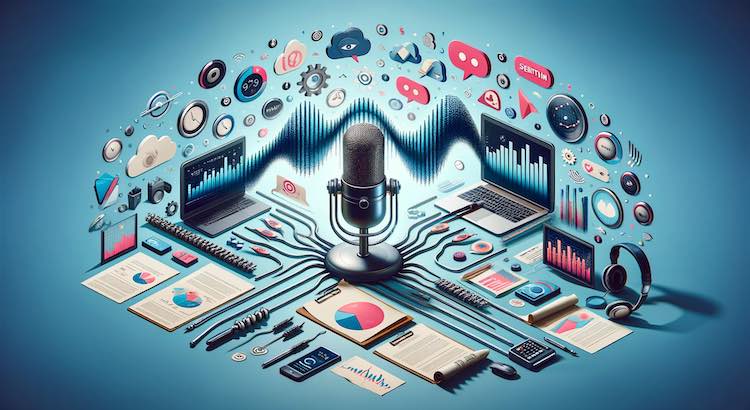Unlocking Marketing Research Insights with Transcription and Text Analysis
Audio content such as customer service calls, interviews, and podcasts contains important information that often goes untapped. Because audio is unstructured, it is hard to analyze for trends or insights. Transcription services solve this problem by turning audio recordings into text. Once in text form, you can use analytics tools to perform sentiment analysis, thematic analysis, and trend detection. This process helps businesses understand customers, spot patterns, and improve products and services.
How Transcription Supports Marketing Analytics
Text data makes it easier for marketing teams to analyze and understand what customers think and want. Here are three main ways transcription aids marketing research:
Sentiment Analysis
Sentiment analysis looks for emotional tones in a body of text. For marketers, this is key. Understanding whether customers feel happy, angry, or neutral helps shape strategies and messaging. Businesses often use transcripts from customer calls or reviews to check consumers' feelings about:
- Product quality
- Brand reputation
- Customer service
According to research, 70% of buying experiences are based on how customers feel they are treated (McKinsey, 2022). Quick sentiment checks help companies react faster to customer needs.
Thematic Analysis
Thematic analysis is about finding patterns or themes in large amounts of text. It helps marketers answer questions like:
- What topics do customers discuss most?
- Are there frequent complaints or requests?
- Which product features attract the most attention?
With accurate transcripts, researchers can spot recurring issues and highlight opportunities. Thematic analysis is especially powerful for sorting customer conversations and social media posts.
Trend Detection
Markets move quickly. Recognizing trends in real time gives brands a competitive advantage. By comparing transcripts over weeks or months, companies can:
- Notice emerging customer needs
- Track changing opinions
- See which products are gaining attention
Trend detection helps with product launches, ad campaigns, and long-term planning. A 2023 survey showed that 62% of business leaders use trend analysis to inform critical decisions (Statista, 2023).
Integrating Transcription with Analytics Tools
Combining transcription with analytic tools turns audio into actionable business insights. Here’s a simple process for getting started:
Step 1: Collect Audio Data
- Gather audio from interviews, focus groups, calls, and podcasts
- Include social media voice messages or video content
Step 2: Transcribe Audio to Text
- Automated transcription is fast for large volumes
- Manual transcription is best for detailed accuracy
- Choose a service that supports your file formats and industry terms
Step 3: Clean and Structure the Data
- Edit transcripts to remove filler words or unrelated content
- Correct errors and ensure names or brands are spelled correctly
- Organize the text for analysis (e.g., group responses by topic)
Step 4: Analyze the Data
- Use analytics software to run sentiment or keyword analysis
- Apply machine learning for advanced text mining, if needed
- Review word clouds, heatmaps, or charts to spot standout trends
Step 5: Generate Actionable Insights
- Summarize findings in clear, simple language
- Make recommendations for marketing or product teams
- Share results with leadership to drive decisions
If you want to test costs before starting, review transcription pricing to plan your budget with confidence.
Real-World Success Stories
Businesses of all sizes use transcription services and text analysis to improve their marketing strategies. Here are examples:
- E-commerce Improvement: A large retailer used transcription services to analyze customer service calls. Sentiment analysis identified regular points of frustration during checkout. The business simplified checkout steps, which boosted customer satisfaction and led to higher conversion rates.
- Enhanced Media Content: A podcast company ran thematic analysis of their transcripts. They discovered listeners wanted more expert guests and actionable tips. Producers used this insight to shape future episodes, resulting in higher engagement and a 40% increase in subscriptions (Company Internal Report, 2023).
These stories show how easy it is to spot meaningful patterns when audio content is transcribed and organized for analysis.
Best Practices and Tips
Follow these guidelines for reliable marketing research using transcripts:
- Choose transcription providers with high accuracy ratings
- Use transcription proofreading services for critical projects
- Protect customer privacy by securing audio and text files
- For global studies, use text translation services to analyze data across languages
- Consider AI transcription subscription plans for ongoing research needs
Conclusion
Transcription and text analysis help marketing teams unlock powerful insights from audio data. Converting audio to text lets you dig deeper into customer opinions, spot new themes, and react to trends faster than ever. As analytics tools get smarter, using professional transcription services will only grow more valuable for smart, data-driven marketing.
GoTranscript offers solutions including accurate transcription, affordable pricing, and expert proofreading. With additional translation, captioning, and subtitling services, GoTranscript makes it easy to manage every aspect of your marketing audio data. Order transcription or order captions seamlessly online and take the first step toward smarter marketing research today.



















 Verified Order
Verified Order